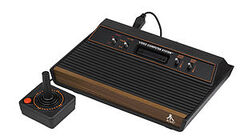| Atari 2600 | |
|---|---|

| |
| Manufacturer | Atari, Inc. |
| Release Date | 11 September 1977 |
| Lifespan | 1977-1992 |
| Discontinued Date | 1 January 1992 |
| Price at Launch | $199.99 |
| Media Type | ROM Cartridge |
| CPU | MOS Technology 6507 @ 1.19 MHz |
| Memory | 128 bytes RAM |
| Input Type(s) | Joystick Controller Paddle Controller Driving Controller Keypad Controller Trak-Ball |
| Best-Selling Game | Pac-Man - 7 million units |
| Predecessor | Atari Pong |
| Successor | Atari 8-Bit Family Atari 5200 |

|
This page or section is under construction. It is currently in the middle of an expansion or major revamping. Be aware that this page may change drastically over time. Also, please try to avoid making major edits unless they are valid to the construction of the page. |
Overview
The Atari 2600, originally sold as the Atari Video Computer System or Atari VCS until November 1982, is a home video game console from Atari, Inc. Released on 11 September 1977, it is credited with popularizing the use of microprocessor-based hardware and games contained on ROM cartridges. This contrasts with the older models of having dedicated hardware that could play only those games that were physically built into the unit. The 2600 was bundled with two joystick controllers, a conjoined pair of paddle controllers, and a game cartridge: initially Combat, and later Pac-Man.
The Atari VCS launched with nine cartridges offering simple, low-resolution games in 2 KiB cartridges. The system found its killer app with the port of Taito's Space Invaders in 1980 and became widely successful, leading to the creation of third-party game developers, notably Activision, and competition from other home console makers such as Mattel and later Coleco. By the end of its primary lifecycle in 1984, the 2600 was home to games with much more advanced visuals and gameplay than the system was designed for, such as scrolling platform adventure Pitfall II: Lost Caverns, which uses around four times the ROM of the launch titles.
Atari invested heavily in two games for the 2600, Pac-Man and E.T. The Extra-Terrestrial, that would become commercial failures and contributed to the video game crash of 1983. The 2600 was shelved as the industry recovered, while Warner sold off the home console division of Atari to Commodore CEO Jack Tramiel. The new Atari Corporation under Tramiel re-released a lower-cost version of the 2600 in 1986, as well as the Atari 7800 that was backwards compatible with the 2600. Atari dropped support for the Atari 2600 on 1 January 1992, after an estimated 30 million units were sold over the system's lifetime.
